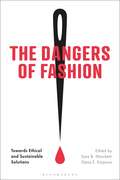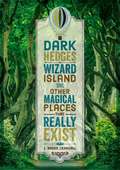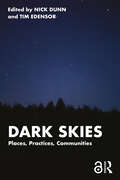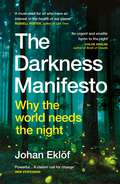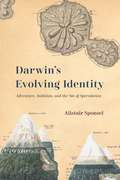- Table View
- List View
Dangerous Earth: What We Wish We Knew about Volcanoes, Hurricanes, Climate Change, Earthquakes, and More
by Ellen PragerThe Earth is a beautiful and wondrous planet, but also frustratingly complex and, at times, violent: much of what has made it livable can also cause catastrophe. Volcanic eruptions create land and produce fertile, nutrient-rich soil, but they can also bury forests, fields, and entire towns under ash, mud, lava, and debris. The very forces that create and recycle Earth’s crust also spawn destructive earthquakes and tsunamis. Water and wind bring and spread life, but in hurricanes they can leave devastation in their wake. And while it is the planet’s warmth that enables life to thrive, rapidly increasing temperatures are causing sea levels to rise and weather events to become more extreme. Today, we know more than ever before about the powerful forces that can cause catastrophe, but significant questions remain. Why can’t we better predict some natural disasters? What do scientists know about them already? What do they wish they knew? In Dangerous Earth, marine scientist and science communicator Ellen Prager explores the science of investigating volcanoes, earthquakes, tsunamis, hurricanes, landslides, rip currents, and—maybe the most perilous hazard of all—climate change. Each chapter considers a specific hazard, begins with a game-changing historical event (like the 1980 eruption of Mt. St. Helens or the landfall and impacts of Hurricane Harvey), and highlights what remains unknown about these dynamic phenomena. Along the way, we hear from scientists trying to read Earth’s warning signs, pass its messages along to the rest of us, and prevent catastrophic loss. A sweeping tour of some of the most awesome forces on our planet—many tragic, yet nonetheless awe-inspiring—Dangerous Earth is an illuminating journey through the undiscovered, unresolved, and in some cases unimagined mysteries that continue to frustrate and fascinate the world’s leading scientists: the “wish-we-knews” that ignite both our curiosity and global change.
Dangerous Materials: From New Global Threats to New Global Responses: A Picture of Transition (NATO Science for Peace and Security Series C: Environmental Security)
by Alberto BrugnoliADRIANO DE MAIO IReR President This publication originated from the workshop on “Control and risk prevention of dangerous materials and crisis management” that took place in Sofia, Bulgaria, in March 2009. The basic idea is that international scientific cooperation can effectively contribute to security, stability and solidarity among nations, through increased collaboration, networking and capacity-building and supporting democratic growth and economic development in Partner Countries. We are all facing new needs and threats, deriving from a world changing constantly its social, political and economic dimension and, for this reason, the international dialogue through civil science represents a way forward to comm- ment to global common issues. In fact, the Lombardy Regional Institute for Research has developed some international activities aiming at establishing networks of scientists and experts in defined areas and subjects. Through one of these activities, the Institute entered in touch with the Science for Peace and Security Programme. In this framework, we decided to share the experience of Lombardy Region on transportation of dangerous materials (half of their total transport in Italy): research and studies in civil area conducted in Lombardy Region are considered the most innovative in Europe for the results obtained. Comparison with diverse international experiences is a great opportunity of implementing present results and applying them to different applications (from civil to anti-terrorism) and extending them to countries other than Italy.
The Dangers of Fashion: Towards Ethical and Sustainable Solutions
by Sara B. Marcketti Elena E. KarpovaFrom sweatshops to fur farming, from polluting chemicals to painful garments, the fashion industry is associated with activities which have had devastating effects on workers, consumers, and the natural world. This ground-breaking volume provides a framework for examining the ethical, social, and environmental dangers that arise as fashion products are designed, manufactured, distributed, and sold within retail outlets, before being consumed and disposed of. Encompassing the cultural, psychological, and physiological aspects of fashion, it offers a comprehensive exploration of the hazards of a global industry. Drawing together an international team of leading textile and apparel experts, The Dangers of Fashion presents original perspectives on a wide range of topics from piracy and counterfeiting to human trafficking; from the effects of globalization on local industry to the peer pressure that governs contemporary ideals of beauty. Rooted in research into industry and consumer practices, it discusses innovative solutions-both potential and existing-to fashion's dangers and moral dilemmas from the viewpoint of individuals, companies, societies, and the global community.
The Dangers of Fashion: Towards Ethical and Sustainable Solutions
From sweatshops to fur farming, from polluting chemicals to painful garments, the fashion industry is associated with activities which have had devastating effects on workers, consumers, and the natural world. This ground-breaking volume provides a framework for examining the ethical, social, and environmental dangers that arise as fashion products are designed, manufactured, distributed, and sold within retail outlets, before being consumed and disposed of. Encompassing the cultural, psychological, and physiological aspects of fashion, it offers a comprehensive exploration of the hazards of a global industry. Drawing together an international team of leading textile and apparel experts, The Dangers of Fashion presents original perspectives on a wide range of topics from piracy and counterfeiting to human trafficking; from the effects of globalization on local industry to the peer pressure that governs contemporary ideals of beauty. Rooted in research into industry and consumer practices, it discusses innovative solutions-both potential and existing-to fashion's dangers and moral dilemmas from the viewpoint of individuals, companies, societies, and the global community.
Danish Design Heritage and Global Sustainability
by Ditte Lysgaard VindWith a bias for action, this book offers valuable insights into the origins of the much-celebrated Danish design tradition and how it can be employed to create design solutions to address today’s environmental crisis using the planetary boundaries as positive creative constraints. Danish design has long been revered for its high-quality aesthetics, materials and craftmanship, encouraging sustainability without compromise. This book explores the lessons to be learnt from Scandinavian design ideals, introduces the philosophy and principles of circular economy and showcases the potential power of combining circular economy and design in helping to mitigate the effects of climate change. It presents a range of case study examples across multiple sectors and includes interviews with Danish designers from architecture, furniture, fashion, digital and industrial design, providing unique insights by some of the world’s leading contemporary designers. Bridging theory and real-world insights and experiences, this book builds on the framework of the 4Rs – The Circular Way: Reduce, Reuse, Recycle and Replace to encourage innovation through the replacement of environmentally damaging materials and business models. A must-read for product designers, industrial designers, consultants, business developers, sustainability professionals and students interested in learning how to design and implement circular, sustainable models into practice.
Danish Design Heritage and Global Sustainability
by Ditte Lysgaard VindWith a bias for action, this book offers valuable insights into the origins of the much-celebrated Danish design tradition and how it can be employed to create design solutions to address today’s environmental crisis using the planetary boundaries as positive creative constraints. Danish design has long been revered for its high-quality aesthetics, materials and craftmanship, encouraging sustainability without compromise. This book explores the lessons to be learnt from Scandinavian design ideals, introduces the philosophy and principles of circular economy and showcases the potential power of combining circular economy and design in helping to mitigate the effects of climate change. It presents a range of case study examples across multiple sectors and includes interviews with Danish designers from architecture, furniture, fashion, digital and industrial design, providing unique insights by some of the world’s leading contemporary designers. Bridging theory and real-world insights and experiences, this book builds on the framework of the 4Rs – The Circular Way: Reduce, Reuse, Recycle and Replace to encourage innovation through the replacement of environmentally damaging materials and business models. A must-read for product designers, industrial designers, consultants, business developers, sustainability professionals and students interested in learning how to design and implement circular, sustainable models into practice.
The Danube River Basin (The Handbook of Environmental Chemistry #39)
by Igor LiskaThis volume offers a comprehensive review of the chemical, biological and hydromorphological quality of the Danube. The first part examines the chemical pollution of surface waters, focusing on organic compounds (with special emphasis given to EU WFD priority substances and Danube River Basin specific pollutants), heavy metals and nutrients. Attention is also given to pollution of groundwater and drinking water resources by hazardous substances and to radioactivity in the Danube. The second part highlights the biology and hydromorphology of the Danube. It focuses on benthic macroinvertebrates, phytobenthos, macrophytes, fish, phytoplankton as well as microbiology, with chapters dedicated to gaps and uncertainties in the ecological status assessment and to invasive alien species. Further chapters dealing with the hydromorphology, sediment management and isotope hydrology complete the overall picture of the status of the Danube.
The Danube River Delta (Earth and Environmental Sciences Library)
by Abdelazim M. Negm Daniel Constantin DiaconuThis unique book presents for the first time the current status of the Danube River Delta, the challenges facing it, and proposed strategies to solve it. One of the biggest challenges is the human effects on the Danube Delta Environment and its lakes that work as sinks for natural and anthropogenic environmental changes, the water management and water flow variability and under climatic conditions including the extreme temperature and precipitation events based on RCMs output and the impact of sedimentation processes on the evolution of the Danube Delta. The book also contains the impact of wind and solar energy on the Delta. The book also presents the integrated approach for sustainable development of the Delta including the structural dynamics of the local economy, the role of tourism activities, integrated waste management in the Danube Delta Biosphere Reserve, demographic dynamics in the Delta, and the population health state. Also, a unique chapter on the opportunities of content exploitation as Language Learning Experiences is applied to Danube Delta. The book will be of great scientific interest to help the graduate students, researchers, stakeholder professional engineers, policy planners, policymakers of three countries to implement their sustainable development plan.
Darboux Transformations in Integrable Systems: Theory and their Applications to Geometry (pdf) (Mathematical Physics Studies #26)
by Chaohao Gu Anning Hu Zixiang ZhouDare To Be Great: Unlock Your Power to Create a Better World
by Polly Higgins‘I know it may not yet look like it, but we are sowing the seeds of greatness for countless generations to come. That is the Great Work of our times. Yours and mine.’ This is a book unlike any other. It does not tell you what you must do, it does not set out a guide for the 10 definitive steps to becoming great by next Thursday. Dare To Be Great is both a playful, inspirational conversation and a heartfelt, lived call, daring each one of us and our society as a whole to become truly great. Celebrated Earth lawyer Polly Higgins was a luminary in the environmental justice movement as she worked to Stop Ecocide across the globe. She was a beacon for how to live the brave, bold lives that, at our best, we imagine for ourselves. This book shares insights from her own remarkable journey, inspiring us to recognise and step into a greatness within – that is not about grandiosity but something far more exciting: aligning with our unique purpose in service of a better world.
Dark Hedges, Wizard Island, and Other Magical Places That Really Exist
by L Rader CrandallFrom a lost city in the desert to a cave alight with thousands of glowworms, learn about some of the most unusual places on earth and the myths, legends, and history behind each of them!Looking at places like The Skeleton Coast in Namibia, Wizard Island in the United States, and The Fairy Tale Route in Germany, The Dark Hedges and Other Magical Places that Really Exist takes young readers on a journey around the world to real places that sound straight out of fantasy. Featuring both natural and man-made wonders, this travel book combines history and storytelling to explore the far reaches of the earth.
Dark Matter and Dark Energy: A Challenge for Modern Cosmology (Astrophysics and Space Science Library #370)
by Sabino Matarrese Monica Colpi Vittorio Gorini Ugo MoschellaThis book brings together reviews from leading international authorities on the developments in the study of dark matter and dark energy, as seen from both their cosmological and particle physics side. Studying the physical and astrophysical properties of the dark components of our Universe is a crucial step towards the ultimate goal of unveiling their nature. The work developed from a doctoral school sponsored by the Italian Society of General Relativity and Gravitation. The book starts with a concise introduction to the standard cosmological model, as well as with a presentation of the theory of linear perturbations around a homogeneous and isotropic background. It covers the particle physics and cosmological aspects of dark matter and (dynamical) dark energy, including a discussion of how modified theories of gravity could provide a possible candidate for dark energy. A detailed presentation is also given of the possible ways of testing the theory in terms of cosmic microwave background, galaxy redshift surveys and weak gravitational lensing observations. Included is a chapter reviewing extensively the direct and indirect methods of detection of the hypothetical dark matter particles. Also included is a self-contained introduction to the techniques and most important results of numerical (e.g. N-body) simulations in cosmology. " This volume will be useful to researchers, PhD and graduate students in Astrophysics, Cosmology Physics and Mathematics, who are interested in cosmology, dark matter and dark energy.
Dark Skies: Places, Practices, Communities
by Nick Dunn Tim EdensorDark Skies addresses a significant gap in knowledge in relation to perspectives from the arts, humanities, and social sciences. In providing a new multi- and interdisciplinary field of inquiry, this book brings together engagements with dark skies from a variety of disciplinary backgrounds, empirical studies, and theoretical orientations. Throughout history, the relationship with dark skies has generated a sense of wonder and awe, as well as providing the basis for important cultural meanings and spiritual beliefs. However, the connection to darks skies is now under threat due to the widespread growth of light pollution and the harmful impacts that this has upon humans, non-humans, and the planet we share. This book, therefore, examines the rich potential of dark skies and their relationships with place, communities, and practices to provide new insights and understandings on their importance for our world in an era of climate emergency and environmental degradation. This book is intended for a wide audience. It will be of interest to scholars, students, and professionals in geography, design, astronomy, anthropology, ecology, history, and public policy, as well as anyone who has an interest in how we can protect the night sky for the benefit of us all and the future generations to follow.
Dark Skies: Places, Practices, Communities
Dark Skies addresses a significant gap in knowledge in relation to perspectives from the arts, humanities, and social sciences. In providing a new multi- and interdisciplinary field of inquiry, this book brings together engagements with dark skies from a variety of disciplinary backgrounds, empirical studies, and theoretical orientations. Throughout history, the relationship with dark skies has generated a sense of wonder and awe, as well as providing the basis for important cultural meanings and spiritual beliefs. However, the connection to darks skies is now under threat due to the widespread growth of light pollution and the harmful impacts that this has upon humans, non-humans, and the planet we share. This book, therefore, examines the rich potential of dark skies and their relationships with place, communities, and practices to provide new insights and understandings on their importance for our world in an era of climate emergency and environmental degradation. This book is intended for a wide audience. It will be of interest to scholars, students, and professionals in geography, design, astronomy, anthropology, ecology, history, and public policy, as well as anyone who has an interest in how we can protect the night sky for the benefit of us all and the future generations to follow.
The Dark Stuff: Stories from the Peatlands
by Donald S. MurrayDonald S. Murray spent much of his childhood either playing or working on the moor, chasing sheep across empty acres and cutting and gathering peat for fuel. The Dark Stuff is an examination of how this landscape affected him and others. Donald explores his early life on the Isle of Lewis together with the experiences of those who lived near moors much further afield, from the Highlands and Islands of Scotland to the Netherlands, Germany, Ireland and even Australia. Examining this environment in all its roles and guises, Donald reflects on the ways that for centuries humans have represented the moor in literature, art and folktale, and he reveals how in some countries, these habitats remain an essential aspect of their industrial heritage and working life today. On his journey, Donald confronts the unexpected – how Europe's peatlands are part of the dark heart of that continent, playing a crucial role in the history of crime and punishment in several countries. He also examines our current perception of moorland, asking how – for the sake, perhaps, of our planet's survival – we can learn to love a landscape we have all too often in our history denigrated, feared and despised.
The Dark Stuff: Stories from the Peatlands
by Donald S. MurrayDonald S. Murray spent much of his childhood either playing or working on the moor, chasing sheep across empty acres and cutting and gathering peat for fuel. The Dark Stuff is an examination of how this landscape affected him and others. Donald explores his early life on the Isle of Lewis together with the experiences of those who lived near moors much further afield, from the Highlands and Islands of Scotland to the Netherlands, Germany, Ireland and even Australia. Examining this environment in all its roles and guises, Donald reflects on the ways that for centuries humans have represented the moor in literature, art and folktale, and he reveals how in some countries, these habitats remain an essential aspect of their industrial heritage and working life today. On his journey, Donald confronts the unexpected – how Europe's peatlands are part of the dark heart of that continent, playing a crucial role in the history of crime and punishment in several countries. He also examines our current perception of moorland, asking how – for the sake, perhaps, of our planet's survival – we can learn to love a landscape we have all too often in our history denigrated, feared and despised.
Dark Tourism: Practice and interpretation (New Directions in Tourism Analysis)
by Glenn Hooper John J. LennonDark Tourism, as well as other terms such as Thanatourism and Grief Tourism, has been much discussed in the past two decades. This volume provides a comprehensive exploration of the subject from the point of view of both practice - how Dark Tourism is performed, what practical and physical considerations exist on site - and interpretation - how Dark Tourism is understood, including issues pertaining to ethics, community involvement and motivation. It showcases a wide range of examples, drawing on the expertise of academics with management and consultancy experience, as well as those from within the social sciences and humanities. Contributors discuss the historical development of Dark Tourism, including its earlier incarnations across Europe, but they also consider its future as a strand within academic discourse, as well as its role within tourism development. Case studies include holocaust sites in Germany, as well as analysis of the legacy of war in places such as the Channel Islands and Malta. Ethical and myriad marketing considerations are also discussed in relation to Ireland, Brazil, Rwanda, Romania, U.K., Nepal and Bosnia-Herzegovina. This book covers issues that are of interest to students and staff across a spectrum of disciplines, from management to the arts and humanities, including conservation and heritage, site management, marketing and community participation.
Dark Tourism: Practice and interpretation (New Directions in Tourism Analysis)
by Glenn Hooper John J. LennonDark Tourism, as well as other terms such as Thanatourism and Grief Tourism, has been much discussed in the past two decades. This volume provides a comprehensive exploration of the subject from the point of view of both practice - how Dark Tourism is performed, what practical and physical considerations exist on site - and interpretation - how Dark Tourism is understood, including issues pertaining to ethics, community involvement and motivation. It showcases a wide range of examples, drawing on the expertise of academics with management and consultancy experience, as well as those from within the social sciences and humanities. Contributors discuss the historical development of Dark Tourism, including its earlier incarnations across Europe, but they also consider its future as a strand within academic discourse, as well as its role within tourism development. Case studies include holocaust sites in Germany, as well as analysis of the legacy of war in places such as the Channel Islands and Malta. Ethical and myriad marketing considerations are also discussed in relation to Ireland, Brazil, Rwanda, Romania, U.K., Nepal and Bosnia-Herzegovina. This book covers issues that are of interest to students and staff across a spectrum of disciplines, from management to the arts and humanities, including conservation and heritage, site management, marketing and community participation.
The Darkness Manifesto: How light pollution threatens the ancient rhythms of life
by Johan EklöfThe Darkness Manifesto urges us to cherish darkness for the sake of the environment, our own wellbeing, and all life on earth.Entire ecosystems rely on natural darkness to flourish, from bats and keen-eyed owls capering across the starry sky to the bioluminescent creatures of the deep. But constant illumination has made light pollution a major threat. By extending our day, humans have disrupted the circadian rhythms necessary to sustain all living things.The Darkness Manifesto lifts night's veil to reveal the domino effect of damage we inflict by keeping the lights on: insects failing to reproduce, plants left unpollinated, countless hunting and migratory patterns eroded. Eye-opening and ultimately encouraging, this book offers simple steps that can benefit ourselves and the planet.'Powerful ... A clarion call for change' New Statesman 'A pleasure to read ... A paean of praise for natural darkness' Financial Times, Book of the Year 'A must-read for all who have an interest in the health of our planet' Russell Foster, author of Life Time
Darstellung der Niederschlagsverteilung in Deutschland durch Isanomalen (Veröffentlichungen des Königlich Preußischen Meterologischen Instituts #7)
by Gustav WussowDieser Buchtitel ist Teil des Digitalisierungsprojekts Springer Book Archives mit Publikationen, die seit den Anfängen des Verlags von 1842 erschienen sind. Der Verlag stellt mit diesem Archiv Quellen für die historische wie auch die disziplingeschichtliche Forschung zur Verfügung, die jeweils im historischen Kontext betrachtet werden müssen. Dieser Titel erschien in der Zeit vor 1945 und wird daher in seiner zeittypischen politisch-ideologischen Ausrichtung vom Verlag nicht beworben.
Darwin, Darwinism and Conservation in the Galapagos Islands: The Legacy of Darwin and its New Applications (Social and Ecological Interactions in the Galapagos Islands)
by Diego Quiroga Ana SevillaThe book explores how Darwin´s legendary and mythologized visit to the Galapagos affected the socioecosystems of the Islands, as well as the cultural and intellectual traditions of Ecuador and Latin America. It highlights in what way the connection between Darwin and the Galapagos has had real, enduring and paradoxical effects in the Archipelago. This Twenty Century construct of the Galapagos as the cradle of Darwin’s theory and insights triggered not only the definition of the Galapagos as a living natural laboratory but also the production of a series of conservation practices and the reshaping of the Galapagos as a tourism destination with an increasingly important flow of tourists that potentially threaten its fragile ecosystems. The book argues that the idea of a Darwinian living laboratory has been limited by the success of the very same constructs that promote its conservation. It suggests critical interpretations of this paradox by questioning many of the dichotomies that have been created to understand nature and its conservation. We also explore some possible ways in which Darwin's ideas can be used to better understand the social and natural threats facing the Islands and to develop sustainable and successful management practices.
Darwin, Geodynamics and Extreme Waves
by Sh. U. GalievThis book examines the reasons behind the resonant amplification of seismic and ocean waves that have the capacity to destroy cities and ocean-going vessels. Using Charles Darwin’s important geophysical research as a starting point, it provides insights into the interaction between earthquakes with volcanoes, seaquake, and tsunami formation.In particular, the author details the observations that Darwin made on a powerful earthquake that occurred in Chile in 1835, noting how the famous naturalist and geologist used the concept of earthquake-induced vertical shock to explain the event's devastating impact. The book then goes on to show how Darwin's concept relates to the catastrophic results of the shallow quakes that recently destroyed Port-au-Prince (Haiti, 2010) and severely damaged Christchurch (New Zealand, 2011). In addition, the author asks whether Darwin's ideas are endorsed by the discoveries of modern science and whether the results of destructive earthquakes can be modeled using strongly nonlinear wave equations. Coverage also proposes that similar equations can be used to simulate the dynamics of many objects on the surface of the Earth, and to model the origin of the Universe, dark matter, and dark energy as strongly nonlinear wave phenomena.The book will appeal to students as well as researchers and engineers in geophysics, seismology, nonlinear wave studies, cosmology, physical oceanography, and ocean and coastal engineering. It will also be of use to those who are interested in the phenomena of natural catastrophes as well as those who want to learn more about the life and work of Charles Darwin.
Darwinian Evolution of Molecules: Physical and Earth-Historical Perspective of the Origin of Life (Advances in Geological Science)
by Hiromoto NakazawaOn the basis of thermodynamic considerations and the Earth’s historical processes, this book argues the physical inevitability of life’s generation and evolution, i.e., Why did life generate? Why does life evolve? Following an introduction to the problem, the hypothesis “Darwinian Evolution of Molecules” is proposed, which explains how, when, and where life was instigated through successive chemical reactions and the survival of selected molecules. The individual processes described are all scientifically reasonable, being verifiable by experiment. The hypothesis is supported by extensive reference to the scientific literature published in academic journals, including some experimental reports from the author’s own research group. The readers of this book will learn that the decreasing temperature of the early Earth led to a reduction in its entropy, inducing the Earth’s materials to order, which entailed ordering of the light elements as organic molecules with subsequent further ordering (i.e., evolution) to systems that can be considered alive (i.e., life). Researchers and students, as well as the non-academic audience, interested in the interdisciplinary problem of the origin of life will find suggestions and possible approaches to the scientific and conceptual problems they may be facing.
Darwin's Evolving Identity: Adventure, Ambition, and the Sin of Speculation
by Alistair SponselWhy—against his mentor’s exhortations to publish—did Charles Darwin take twenty years to reveal his theory of evolution by natural selection? In Darwin’s Evolving Identity, Alistair Sponsel argues that Darwin adopted this cautious approach to atone for his provocative theorizing as a young author spurred by that mentor, the geologist Charles Lyell. While we might expect him to have been tormented by guilt about his private study of evolution, Darwin was most distressed by harsh reactions to his published work on coral reefs, volcanoes, and earthquakes, judging himself guilty of an authorial “sin of speculation.” It was the battle to defend himself against charges of overzealous theorizing as a geologist, rather than the prospect of broader public outcry over evolution, which made Darwin such a cautious author of Origin of Species. Drawing on his own ambitious research in Darwin’s manuscripts and at the Beagle’s remotest ports of call, Sponsel takes us from the ocean to the Origin and beyond. He provides a vivid new picture of Darwin’s career as a voyaging naturalist and metropolitan author, and in doing so makes a bold argument about how we should understand the history of scientific theories.
Darwin's Evolving Identity: Adventure, Ambition, and the Sin of Speculation
by Alistair SponselWhy—against his mentor’s exhortations to publish—did Charles Darwin take twenty years to reveal his theory of evolution by natural selection? In Darwin’s Evolving Identity, Alistair Sponsel argues that Darwin adopted this cautious approach to atone for his provocative theorizing as a young author spurred by that mentor, the geologist Charles Lyell. While we might expect him to have been tormented by guilt about his private study of evolution, Darwin was most distressed by harsh reactions to his published work on coral reefs, volcanoes, and earthquakes, judging himself guilty of an authorial “sin of speculation.” It was the battle to defend himself against charges of overzealous theorizing as a geologist, rather than the prospect of broader public outcry over evolution, which made Darwin such a cautious author of Origin of Species. Drawing on his own ambitious research in Darwin’s manuscripts and at the Beagle’s remotest ports of call, Sponsel takes us from the ocean to the Origin and beyond. He provides a vivid new picture of Darwin’s career as a voyaging naturalist and metropolitan author, and in doing so makes a bold argument about how we should understand the history of scientific theories.



